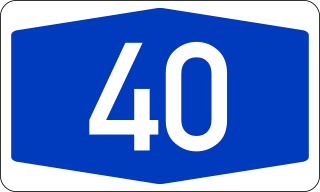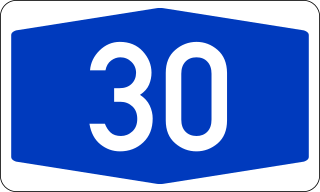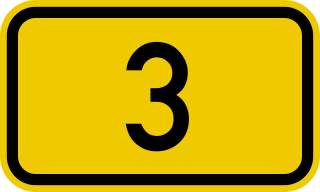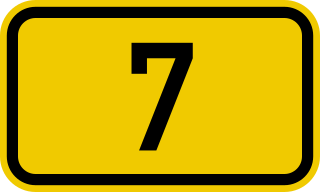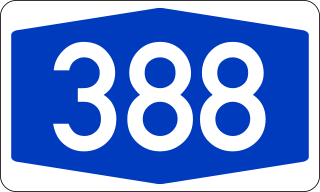| B9 | |
|---|---|
| Bundesstraße 9 | |
 | |
| Route information | |
| Length | 450 km (280 mi) |
| Major junctions | |
| North end | Kranenburg |
| South end | Scheibenhardt |
| Location | |
| States | North Rhine-Westphalia, Rhineland-Palatinate |
| Highway system | |
The Bundesstraße 9 (abbr. B9 [1] ) is a German federal highway. It follows the left side of the Rhine from the Dutch border at Kranenburg upstream to the French border near the city of Lauterbourg, where it connects to the French A35 autoroute. The origins of the road can be traced back to Ancient Rome.
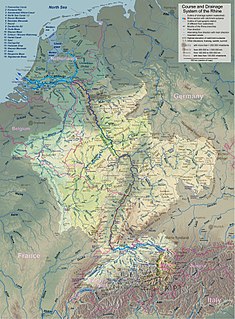
The Rhine is a European river that begins in the Swiss canton of Graubünden in the southeastern Swiss Alps, forms part of the Swiss-Liechtenstein, Swiss-Austrian, Swiss-German and then the Franco-German border, then flows through the German Rhineland and the Netherlands and eventually empties into the North Sea.
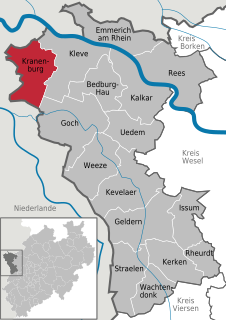
Kranenburg is a town and municipality in the district of Cleves in the state of North Rhine-Westphalia, Germany. It is located near the border with the Netherlands, 12 kilometres (7 mi) south-east of Nijmegen and 11 kilometres (7 mi) west of Cleves. Since 1992, Kranenburg has evolved into a commuter town for Nijmegen, driven almost exclusively by lower real estate prices. The village has always focussed on the Dutch city of Nijmegen, and the local language was Dutch until far into the 19th century. More recent, the extremely large influx of Dutch financially driven, cross-border migrants has changed the profile of this small rural border town significantly, resulting in social discomfort and unrest with the native German population.

Lauterbourg is a commune and Bas-Rhin department in the Grand Est administrative region in north-eastern France. Situated on the German border and not far from the German city of Karlsruhe, it is the easternmost commune in Metropolitan France. The German town across the border is Neulauterburg.


Some parts of the road have since been downgraded. The strip from Osterath to Neuss has been downgraded due to the Bundesautobahn 57 running in parallel. Between Cologne and Bonn the Bundesautobahn 555 replaced the Bundesstraße 9. From Bingen to Mainz the road has been replaced by the Bundesautobahn 60, and in the south the Bundesautobahn 65 replaced the Bundesstraße 9. However, some parts of the Bundesstraße 9 have been built to autobahn standards as well, most notably the part between Sinzig and Koblenz as well as the part between Frankenthal and Wörth am Rhein.

Neuss is a city in North Rhine-Westphalia, Germany. It is located on the west bank of the Rhine opposing Düsseldorf. Neuss is the largest city within the Rhein-Kreis Neuss district. It is primarily known for its historic Roman sites, as well as the annual Neusser Bürger-Schützenfest. Neuss and Trier share the title of "Germany's oldest city"; and in 1984 Neuss celebrated the 2000 year anniversary of its founding in 16 BCE.
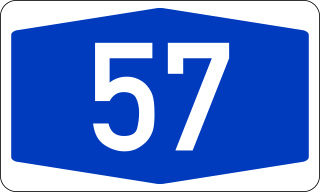
Bundesautobahn 57 is a German Autobahn that begins at the Dutch-German border near Goch and ends in Köln. It runs parallel to the Rhine River. Neuss and Krefeld are the biggest cities at this motorway. The A 57 is continuation of the Dutch A77. Because of its high economic importance, its nickname is "Trans-Niederrhein-Magistrale". Most of it is two lanes each way only and prone to traffic jams in the rush hour. Currently the sections junction 15 - 18, 19 - 24 and 29 - 30 have three lanes each way. The section from junction 28 to 29 southbound has the possibility to open the hard shoulder as a third lane in heavy traffic. Traffic jams are possible between junctions 10 and 15, 17 and 20 as well as around junctions 27/28. There is a variable speed limit between junction 10 and 23. The sections from junction 23 to 24 and 27 to 30 have a limit of 100 km/h. Between junctions 27 and 28 the limit was reduced to 80 km/h between 10pm and 6am at night.

Cologne is the largest city of Germany's most populous federal state of North Rhine-Westphalia, and its 1 million+ (2016) inhabitants make it the fourth most populous city in Germany after Berlin, Hamburg, and Munich. The largest city on the Rhine, it is also the most populous city both of the Rhine-Ruhr Metropolitan Region, which is Germany's largest and one of Europe's major metropolitan areas, and of the Rhineland. Centred on the left bank of the Rhine, Cologne is about 45 kilometres (28 mi) southeast of North Rhine-Westphalia's capital of Düsseldorf and 25 kilometres (16 mi) northwest of Bonn. It is the largest city in the Central Franconian and Ripuarian dialect areas.
The part between Mainz and Worms is closed to transit truck traffic. Previously, this road had been commonly used by drivers who wanted to avoid the tolls on the autobahns. These drivers are now forced to take the Bundesautobahn 63 and Bundesautobahn 61.

Mainz is the capital and largest city of Rhineland-Palatinate, Germany. The city is located on the Rhine river at its confluence with the Main river, opposite Wiesbaden on the border with Hesse. Mainz is an independent city with a population of 206,628 (2015) and forms part of the Frankfurt Rhine-Main Metropolitan Region.
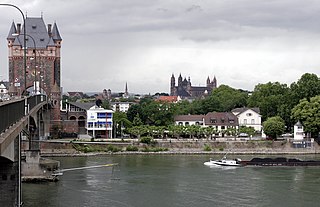
Worms is a city in Rhineland-Palatinate, Germany, situated on the Upper Rhine about 60 kilometres south-southwest of Frankfurt-am-Main. It had approximately 82,000 inhabitants as of 2015.

Bundesautobahn 63 is an autobahn in southwestern Germany. It connects the Mainz area to Kaiserslautern and the A 6 and is therefore an important connection between the Rhine/Main and the Saar areas. It was constructed during the 1980/90s and finished 2004

